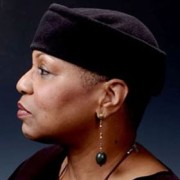A.M. Weaver
A.M. was a practicing artist, curator, and writer. Her goal was to shape discourse and disseminate information on visual artists of color and women artists. Early in her career—as a sculptor and printmaker—she created a visual language through a socio-political prism that conveyed the challenges of being a black woman artist. As she honed her skills as a curator and writer, she used these early expressions to inform her understanding and examination of other artists. She participated in Bob Blackburn’s Printmaking Workshop in New York during the late 1980’s and worked as the Director of Visual Arts at the Painted Bride Art Center in Philadelphia. While at the Bride she organized a number of important shows including a diverse media series entitled Whose Vanguard?, which culminated in a Lesbian Film Festival in 1998. Some of her curatorial projects focused on women and women’s art in relationship to feminism. Examples include hallmark exhibits such as: Screenings: Public & Private (2004) and Convergence (2002). As a journalist, A.M. continued to examine the work of a diverse group of artists whose concerns range from modernism to socio-political percepts. She also wrote critical essays on how capitalism, the military industrial complex, and racism in America could be challenged through art.
Awarded Grants
2009
Leeway Transformation Award (LTA)
Overview
A.M. was a practicing artist, curator, and writer. Her goal was to shape discourse and disseminate information on visual artists of color and women artists. Early in her career—as a sculptor and printmaker—she created a visual language through a socio-political prism that conveyed the challenges of being a black woman artist. As she honed her skills as a curator and writer, she used these early expressions to inform her understanding and examination of other artists. She participated in Bob Blackburn’s Printmaking Workshop in New York during the late 1980’s and worked as the Director of Visual Arts at the Painted Bride Art Center in Philadelphia. While at the Bride she organized a number of important shows including a diverse media series entitled Whose Vanguard?, which culminated in a Lesbian Film Festival in 1998. Some of her curatorial projects focused on women and women’s art in relationship to feminism. Examples include hallmark exhibits such as: Screenings: Public & Private (2004) and Convergence (2002). As a journalist, A.M. continued to examine the work of a diverse group of artists whose concerns range from modernism to socio-political percepts. She also wrote critical essays on how capitalism, the military industrial complex, and racism in America could be challenged through art.







